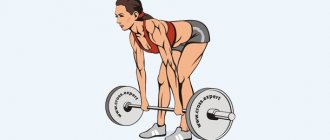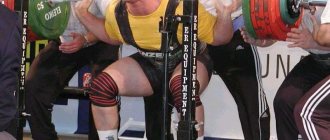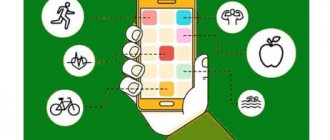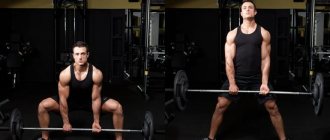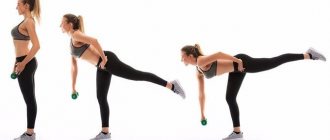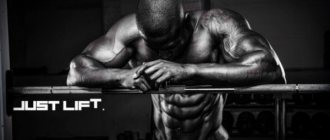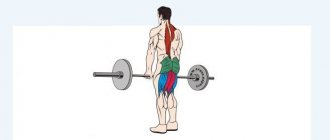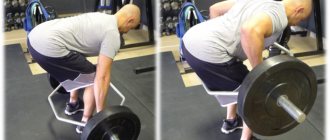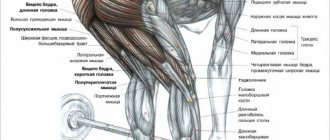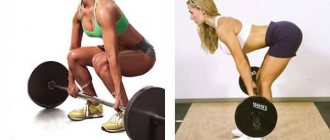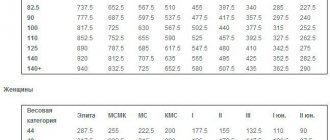Which deadlift technique is best for gaining muscle mass and increasing strength? Find out what experts think about this.
Which deadlift technique is best?
For decades, powerlifters have debated which type of deadlift is better: classic or sumo. The difference between them is significant.
Classic deadlift
With the classic deadlift, the feet are placed at the same level as the hips (narrower than shoulder width), and the bar is located at least at the level of the middle of the foot (and preferably closer to the shin).
Bend your knees, keeping your back as straight as possible.
Squat down, but don't round your back. The longer your hips, the higher your pelvis will be. Take the bar wider than your feet, but not too wide.
You can grab the barbell with an overhand grip or use a mixed grip (with one hand we grab the barbell from above, the other from below). Do not grab the bar from below with both hands at once. Do not use an open grip (without gripping the barbell with your thumb). This may result in injury.
Pull your shoulders back and push your chest forward a little. Pressing your feet into the floor, use your legs to lift the bar off the ground. When the bar is at knee level, push your pelvis forward and straighten up. Arms are completely straight. Lock yourself in this position, keeping your legs straight and your chest forward. Doing everything in reverse order, place the barbell back on the floor.
Sumo style deadlift
The sumo-style deadlift is performed in the stance that sumo wrestlers take before the start of the bout. This is where the name came from.
The torso is positioned more vertically than with a classic deadlift. The hips drop lower, which means the lower back will be less involved in the movement.
But the quadriceps and inner thigh work much stronger. At the beginning of the movement, you are in the same position as in a wide-legged squat. We hold the bar narrower than the legs are, but the bar is moved towards the shin, as with the classic deadlift.
There are many more factors that influence the performance of the exercise, but they depend on individual characteristics.
Which type of deadlift is more effective?
There is a lot of discussion on this issue. Many powerlifters practice both versions to get the most out of both.
The controversy stems from the fact that many powerlifters lift in sumo-style competitions.
Due to the wider stance of the legs, the amplitude is significantly reduced compared to the classic deadlift.
Therefore, if an athlete sets a record in a sumo stand, he is immediately subjected to a barrage of criticism. Some even think that sumo-style deadlifts should be banned in competitions. Others believe that you just need to successfully lift the barbell from point “A” to point “B”, and it doesn’t matter in what way.
Given that the movement is performed without cheating, why not choose a shorter amplitude? Many people use a wide arm stance when bench pressing or a wide leg stance when squatting. Therefore, sumo deadlift has a right to exist.
Useful article: “10 tips on how to increase weights and results in the bench press”
Deadlift and bodybuilding workouts
There is also a lot of debate about whether bodybuilders need deadlifts. Many coaches and athletes believe that the classic deadlift is more suitable for gaining muscle mass, as it involves all muscle groups of the body. This will help you achieve the best possible result. Some people believe that the sumo deadlift is better because there is no need to go through such a large amplitude. In addition, the leg muscles are more involved in the work, which reduces the risk of lower back injury.
If an athlete uses a large working weight, he increases the training volume, which will have a positive effect on progress. This is an important factor for bodybuilder training.
15-prakticheskikh-sovetov-dlya-uvelicheniya-stanovoj-tyagi
Throughout my time in the strength industry, I have realized that the deadlift is often misunderstood.
I love deadlifts as a test of strength. There are no frames, nothing unnecessary, just you against the barbell. But it seems many people end up playing a guessing game when it comes to increasing their cravings. By training the deadlift, you will improve, or at least not detract from, your performance in other aspects of your training. But there are numerous questions - with or without a belt? With or without straps? And many more.
But it's time to get down to business. You should test deadlift strategies and see how they work for you. This article provides you with fifteen practical strategies to start using right away if you're serious about increasing your cravings.
Read all of them and see what might help you.
Do deadlifts more often.
If you're reading this article, you want to improve your maximum deadlift. But if you're doing it (or variations of it) every few weeks or even months, you're not giving the cravings enough love to get them to grow. Of course, you can improve your deadlift by training other lifts, but if you really want to pull more off the floor, deadlift more often.
Do deadlifts less often.
If you perform classic deadlifts several times a week in a desperate attempt to increase them, you will need time to recover, and you will start the next workout under-recovered, which can lead to injury. Clearly this is the wrong way. I have learned over the years that slow successes are sustainable successes. Understand that developing cravings takes time, but it is worth it.
If you are a classic lifter, switch to sumo.
I know for a fact that most regular deadlifters have never done sumo before. Try sumo a few times before saying it's not for you and rejecting the option. It's like my son trying a new food, I ask him to try it before he tells me he doesn't like it. Use sumo as a variation, at least for a full circuit. Sumo will help improve your leg strength.
If you pull in sumo, switch to classics.
If you pull in sumo, it's probably because you've realized that sumo is better for you and your proportions. And I'm not going to dissuade you. But consider working in the classics in a loop. This will put more strain on your hamstrings and back. Using a classic that hits these areas harder will give you a lot before you go back to sumo.
The deadlift starts from the rack.
Understand that the deadlift does not start when you start pulling the barbell. Not even when you're in the bottom position and ready to pull. It starts from the moment you stand in front of the barbell. At this moment you need to place your feet, take the correct position and create tension in the body before touching the bar.
Tighten your buttocks.
Of course, this can be given to many - in theory. But are you squeezing your glutes as hard as you can before deadlifting? You must do this before you begin to pull and maintain that tension. Trying to create this tension while lifting will be too late.
Get ready.
A “grab and rip” slogan may look good on a t-shirt, but it rarely looks good on a pull. Take your time, make sure you are standing in the right position and tense.
Work on your grip.
It doesn't matter if we're talking about one heavy set or max reps, a super strong grip will help you. Do farmer's walks, thick bar rows, static holds, high rep sets, or a combination of these.
Hold it as tight as possible
When your brain thinks you can't hold something, it will send a signal to your body that what you are doing is too dangerous. As a result, your brain will shut down your body and you will not be able to lift the weight. If you grip the bar as tightly as possible, not only are you less likely to physically release your grip, but your body is also more likely to think it can perform the deadlift.
Break the neck.
On your approach, break the bar in half. Or at least try. This action will help you tighten your lats, which in turn will help you keep the bar closer to your body. And this will help you achieve the rise. So break this damn bar!
Pull the bar towards you.
So you're working on breaking the bar. This is good. Now remember what you are trying to achieve. This action will help you keep the bar close, but you also have to focus on pulling the bar toward you and up along your body for this to happen.
Engage your hips.
Once the bar has passed your knees, stop thinking about standing up and start thinking about squeezing your glutes as hard as you can and driving your hips forward so they touch the bar. What, forward, not up? Yes. Give it a try.
Do a deadlift from the pit.
Stand on something and get into a low position in a super tense position. Imagine that you want to push through what you're standing on as you pull a barbell from the floor. This will help teach the legs proper function, position, and tension.
Do rows from the plates
Block pulls are a fantastic way to feel more weight in your hands. You can do bar rows of any height, but if I had to pick one, it would be just below the knees. This is quite low. Work on lifting from this point of pull. This is important for practicing the entire deadlift.
Standing for several times.
If you've never tried doing a deadlift set of eight to 12 reps at the end of a heavy lifting workout, I suggest you give it a try. Use a weight that you do 4-5 times. To create the desired effect, you need to release the barbell at the point when you can no longer pull, throw it and stand up, and repeat this every time. Performing deadlifts this way when your muscles are a little tired will teach your body to find the most efficient technique for lifting the bar.
Original article: https://breakingmuscle.com/strength-conditioning/15-practical-strategies-to-increase-your-deadlift-max
Deadlift with trap bar
This is a barbell, in the center of which there is a free rectangular space where the athlete stands. The handles are located on each side perpendicular to the body. This bar is often used to perform shrugs, but deadlifting with it also has some advantages:
- There is no friction between the bar and the legs;
- You can hold the body strictly vertically;
- The load on the lower back is reduced;
- Anatomically, the arms are in a more natural position.
Some experts believe that the trap bar deadlift is more biomechanically similar to a squat than a deadlift. During a “regular” deadlift the weight is in the front, but here it is on the side, so the load is very different.
How to choose the right working weight?
In the initial stages of training, safety and technique training are the main tasks. Therefore, select the minimum weight and perform 10-12 repetitions. While the weight of the pancakes is insignificant, and accordingly their diameter is smaller, which brings the bar even closer to the floor, you can perform the option from plinths. This will reduce the range of motion and prepare the back muscles and ligaments.
After getting used to and mastering the simple version, you can perform the version from the floor, increasing the weight of the bar to 70% of the maximum weight.
Next, you can select the weight for 6-8 repetitions for 3-6 approaches.
Deadlift from plates
A conversation about deadlifts in bodybuilding would not be complete without mentioning deadlifts from blocks, or from restraints in a power rack. When deadlifting from plates, the barbell is at knee level. Some people think this exercise is useful for gaining muscle mass, while others think it’s stupid.
Block rows are popular because they are less damaging and help isolate the back muscles without the risk of injury.
All this is true, but the true reason for its popularity lies elsewhere. Most people do it to boost their ego by lifting heavy weights. It's impressive for newbies, but gym veterans know the drill. If you do this exercise correctly, then the working weight is not the most important thing.
7. Train with people who can lift harder than you.
Having the right mindset in the deadlift is perhaps more important than in any other exercise. To lift record weights, find a group of strong guys in the gym who can lift really hard. They will help with advice and add motivation. You will notice that the atmosphere itself helps your deadlift progress.
An example of a two-day training program that includes the above techniques to increase your deadlift results. (Attention: only for experienced athletes! – Zozhnik’s note).
1. Maximum Effort Day
2. Dynamic Effort Day
Translation for Zozhnik: Alexey Rebulicommando
